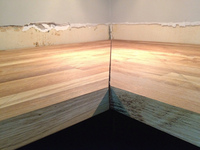The Effect of Shrinkage to Wood Projects
Gloabl Wood Source on 26th Jan 2015

Quality woodworking is about selecting the right lumber and ensuring the quality of your wood project.To do this, a good craftsman needs to understand wood material.
Moisture in Wood
You very well know that lumber is derived from trees which have a cellular structure.The cells store water flowing from the roots and throughout the tree trunk. The trunk has two distinct sections:the outer sapwood and the inner heartwood.It is in the outer ring of sapwood that water flows as sap.When trees are cut to expose the sapwood, you’ll notice sap dripping out of the protective covering of bark.
Sapwood has a lighter color and contains more moisture in its living cells.As the tree ages, new outermost sapwood layers grow.The cells of the innermost sapwood layers die.They become part of the heartwood core made up of inactive cells.Heartwood cell walls contain moisture but their cell cavities or lumen dry and fill with organic matter giving heartwood more density.Heartwood has lesser moisture content.In most tree species, it has a darker color than the surrounding sapwood.
When the tree is cut into lumber, moisture in the wood pieces (heartwood and sapwood) is held by the wood’s inactive cell walls.If the cell walls are well saturated, then the wood’s moisture content is said to be at fiber saturation point.
The dimensions of the wood will change if the moisture content in the wood is below saturation and not the same as the surrounding humidity.Wood dimensions do not change if moisture content is above the saturation point.
Shrinkage or Swelling
Wood will shrink as it loses moisture in its inactive cell walls to the drier humidity of its environment.The same wood will swell to gain moisture to balance with a highly humid environment.
One good example of the changing dimensions of wood is your wooden drawer that gets stuck on humid summer days but moves freely on dry winter days.
Because it is exposed to the daily weather changes as well as the seasonal changes in the relative humidity of the surrounding air, wood in service always undergoes slight changes in its moisture content.
The shrinking or swelling can result in the loosening, checking, splitting and warping of wood.It is important to understand this to avoid defects in seasonal projects.
Lumber Behavior
Lumber behaves differently according to the way the wood pieces are sawn or cut from a log.
Flat-sawn or plain lumber is cut from a log tangential to the annual rings.Quarter-sawn or radial lumber is cut radially from the center or pith and near-parallel to the grains.
Wood shrinks the most along the direction of the growth rings (tangential). It shrinks half as much across the rings (radial) and shrinks slightly along the grain (longitudinal).
The differences in shrinkage along with the curvature of annual rings can combine to warp or distort the shape of wood pieces.Common deformities are bows, crooks, twists, cupping, kinks, checks and cracks.
Unavoidable contraction and expansion of wood can cause undesirable defects in your wood project.Open joints, gaps in strip flooring, warped and swollen surfaces, cracking, splitting can impair the quality and performance of the wood product.
Quality Woodwork
Use quality lumber for fine woodworking projects.
Get a good wood supplier who knows the length of time and drying processes involved before wood becomes ready material for your project.Air seasoning takes months for freshly-cut timber to dry considerably.Even for kiln-dried timber, controlled uniform drying is necessary to minimize wood deformation and deliver wood in the shortest time.
Ask from where and how long before your Exotic Wood items get delivered for your project.Even Domestic Wood undergoes moisture content and dimensional changes from stockpiles, through shipment, during fabrication, while in transit, during production, delivery and storage, then finally service use.
Plan your Wood projects to acclimatize the wood material close to the moisture content the finished product will have in service.
- If you build Tone wood instruments in a humid location then ship them to a dry one, contraction will occur and they will split and crack.
- Hardwood flooring looks great.But if you build your flooring with material that swells or shrinks, that finely fitting floor will creak or bear gaps.
Use wood that has dimensional stability and decay resistance for furniture projects.Experienced woodworkers prefer heartwood not only for its texture, grain, pattern and color, but also for its minimal shrinking and swelling.Quarter-sawn lumber is expensive but it has less shrinking and swelling.Inspect the end grain.Wood pieces with tighter growth rings have less dimensional movement.If you always prefer firm-standing tables, longitudinally-cut lumber is good for even-length tablelegs because shrinkage in length is minimal.
Slabsneed to be dried thoroughly because they may have sapwood.Wood with a lot of moisture is susceptible to fungus growth.Inspect wood for knots, fungi, growth issues, insect bores, even for lightning strikes, or improper drying and milling.
Always inspect your lumber for dimensional defects.

